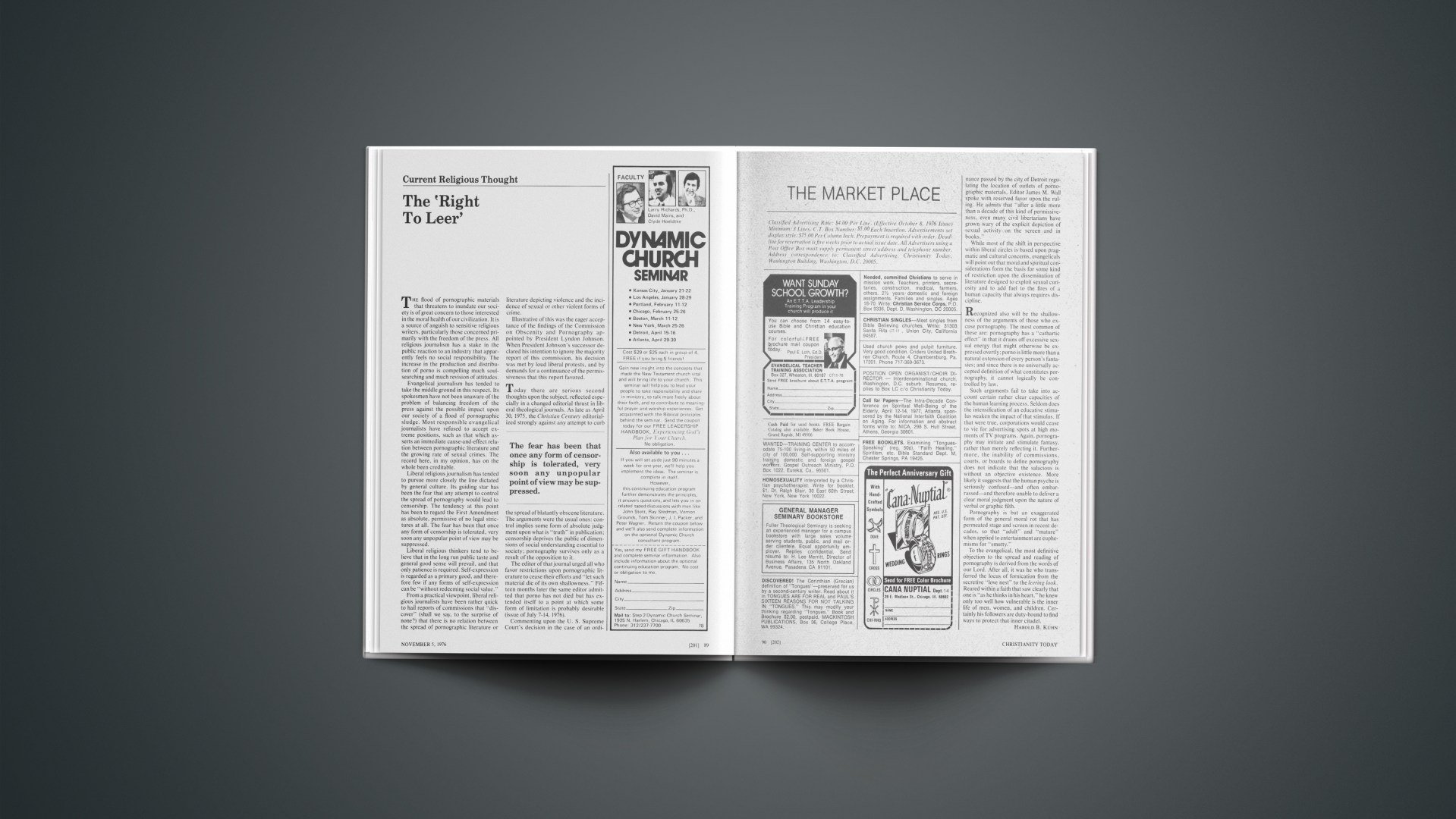The flood of pornographic materials that threatens to inundate our society is of great concern to those interested in the moral health of our civilization. It is a source of anguish to sensitive religious writers, particularly those concerned primarily with the freedom of the press. All religious journalism has a stake in the public reaction to an industry that apparently feels no social responsibility. The increase in the production and distribution of porno is compelling much soul-searching and much revision of attitudes.
Evangelical journalism has tended to take the middle ground in this respect. Its spokesmen have not been unaware of the problem of balancing freedom of the press against the possible impact upon our society of a flood of pornographic sludge. Most responsible evangelical journalists have refused to accept extreme positions, such as that which asserts an immediate cause-and-effect relation between pornographic literature and the growing rate of sexual crimes. The record here, in my opinion, has on the whole been creditable.
Liberal religious journalism has tended to pursue more closely the line dictated by general culture. Its guiding star has been the fear that any attempt to control the spread of pornography would lead to censorship. The tendency at this point has been to regard the First Amendment as absolute, permissive of no legal strictures at all. The fear has been that once any form of censorship is tolerated, very soon any unpopular point of view may be suppressed.
Liberal religious thinkers tend to believe that in the long run public taste and general good sense will prevail, and that only patience is required. Self-expression is regarded as a primary good, and therefore few if any forms of self-expression can be “without redeeming social value.” From a practical viewpoint, liberal religious journalists have been rather quick to hail reports of commissions that “discover” (shall we say, to the surprise of none?) that there is no relation between the spread of pornographic literature or literature depicting violence and the incidence of sexual or other violent forms of crime.
Illustrative of this was the eager acceptance of the findings of the Commission on Obscenity and Pornography appointed by President Lyndon Johnson. When President Johnson’s successor declared his intention to ignore the majority report of this commission, his decision was met by loud liberal protests, and by demands for a continuance of the permissiveness that this report favored.
Today there are serious second thoughts upon the subject, reflected especially in a changed editorial thrust in liberal theological journals. As late as April 30, 1975, the Christian Century editorialized strongly against any attempt to curb the spread of blatantly obscene literature. The arguments were the usual ones: control implies some form of absolute judgment upon what is “truth” in publication; censorship deprives the public of dimensions of social understanding essential to society; pornography survives only as a result of the opposition to it.
The editor of that journal urged all who favor restrictions upon pornographic literature to cease their efforts and “let such material die of its own shallowness.” Fifteen months later the same editor admitted that porno has not died but has extended itself to a point at which some form of limitation is probably desirable (issue of July 7–14, 1976).
Commenting upon the U. S. Supreme Court’s decision in the case of an ordinance passed by the city of Detroit regulating the location of outlets of pornographic materials, Editor James M. Wall spoke with reserved favor upon the ruling. He admits that “after a little more than a decade of this kind of permissiveness, even many civil libertarians have grown wary of the explicit depiction of sexual activity on the screen and in books.”
While most of the shift in perspective within liberal circles is based upon pragmatic and cultural concerns, evangelicals will point out that moral and spiritual considerations form the basis for some kind of restriction upon the dissemination of literature designed to exploit sexual curiosity and to add fuel to the fires of a human capacity that always requires discipline.
Recognized also will be the shallowness of the arguments of those who excuse pornography. The most common of these are: pornography has a “cathartic effect” in that it drains off excessive sexual energy that might otherwise be expressed overtly; porno is little more than a natural extension of every person’s fantasies; and since there is no universally accepted definition of what constitutes pornography, it cannot logically be controlled by law.
Such arguments fail to take into account certain rather clear capacities of the human learning process. Seldom does the intensification of an educative stimulus weaken the impact of that stimulus. If that were true, corporations would cease to vie for advertising spots at high moments of TV programs. Again, pornography may initiate and stimulate fantasy, rather than merely reflecting it. Furthermore, the inability of commissions, courts, or boards to define pornography does not indicate that the salacious is without an objective existence. More likely it suggests that the human psyche is seriously confused—and often embarrassed—and therefore unable to deliver a clear moral judgment upon the nature of verbal or graphic filth.
Pornography is but an exaggerated form of the general moral rot that has permeated stage and screen in recent decades, so that “adult” and “mature” when applied to entertainment are euphemisms for “smutty.”
To the evangelical, the most definitive objection to the spread and reading of pornography is derived from the words of our Lord. After all, it was he who transferred the locus of fornication from the secretive “love nest” to the leering look. Reared within a faith that saw clearly that one is “as he thinks in his heart,” he knew only too well how vulnerable is the inner life of men, women, and children. Certainly his followers are duty-bound to find ways to protect that inner citadel.










